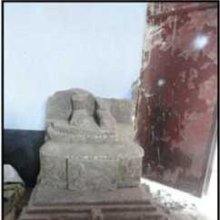Suvidhinatha, Suvidhinātha, Suvidhi-natha: 2 definitions
Introduction:
Suvidhinatha means something in Jainism, Prakrit. If you want to know the exact meaning, history, etymology or English translation of this term then check out the descriptions on this page. Add your comment or reference to a book if you want to contribute to this summary article.
Images (photo gallery)
In Jainism
General definition (in Jainism)
Source: Wisdom Library: JainismSuvidhinātha (सुविधिनाथ):—Another name for Puṣpadantanātha, the ninth Tīrthaṅkara of Janism. This is name is also known as Suvidhi.
Source: archive.org: The Jaina IconographySuvidhinātha (सुविधिनाथ) refers to the ninth of twenty-four Tīrthaṃkaras or Jinas, commonly depicted in Jaina iconography.—Suvidhinātha has two names given to him, another being Puṣpadanta. There is a dispute over his emblem. Some say, it is a dolphin (Makara); others declare it is a crab. His Yakṣa and Yakṣiṇī are named Ajita and Sutārī Devī (Digambara: Mahākalī) respectively. The chowri-bearer has the name of Maghavatarāja. The religious tree under which he attained the Kevala knowledge is the Nāga according to some authorities, Malli according to other authorities.
From patriarchical history, we gather his native place was called Kākandīnagara. His father was the ruling prince by the name of Sugrīva and his mother was named Rāmā, his place of Nirvāṇa was Sameta-Śikhara or Mount Pārasnātha.
The two names have two origins as might be expected. The name “Suvidhinātha” was given to him because after an internecine warfare fought by his kingly relatives, they gave up fighting and took to performing religious duties. His birth eventually brought “good order” (Suvidhi) to the distracted family. The other name, namely, Puṣpadanta was derived from the fact that the Jina’s teeth resembled the buds of a flower (puṣpa). The origin of his symbols seems prima facie rather enigmatic. Neither a crocodile nor a crab has been dreamt of by the Jina’s mother. His father was the lord of Kākandī. Curiously, Kākandī is called Kākandīnagara (Sanskrit: Kiṣkindhānagara). Let us remember, his father is called Sugrīva, his mother has the name of Rāmā. All this has curious association with the Rāmāyaṇa. The Kiṣkindha of the Rāmāyaṇa was situated on the sea. Hence, it is evident that aquatic animals like a crocodile or a crab have come to be the emblems of this Tīrthaṃkara. His Yakṣa Ajita for the same reason has tortoise as vehicle and his Yakṣiṇī Sutārā Devī has an urn symbolising her intimate connexion with waters.

Jainism is an Indian religion of Dharma whose doctrine revolves around harmlessness (ahimsa) towards every living being. The two major branches (Digambara and Svetambara) of Jainism stimulate self-control (or, shramana, ‘self-reliance’) and spiritual development through a path of peace for the soul to progess to the ultimate goal.
See also (Relevant definitions)
Partial matches: Natha, Suvidhi.
Full-text (+4): Suvidhi, Sutara, Sugriva, Sutaridevi, Sutaradevi, Malli, Maghavataraja, Kakandi, Adipta, Rama, Ajita, Pundarikini, Sutari, Pushpadanta, Jagannanda, Pushpadantanatha, Naga, Kakandinagara, Kishkindha, Kishkindhanagara.
Relevant text
Search found 4 books and stories containing Suvidhinatha, Suvidhinātha, Suvidhi-natha, Suvidhi-nātha; (plurals include: Suvidhinathas, Suvidhināthas, nathas, nāthas). You can also click to the full overview containing English textual excerpts. Below are direct links for the most relevant articles:
Jain Remains of Ancient Bengal (by Shubha Majumder)
Images of Tīrthaṅkara Suvidhinātha or Puṣpadanta < [Chapter 6 - Iconographic Study of Jaina Sculptural Remains]
The twenty-four Tīrthaṅkaras and their Yakṣas and Yakṣiṇīs < [Chapter 6 - Iconographic Study of Jaina Sculptural Remains]
Meaning of Tīrthaṅkara < [Chapter 1 - Introduction and Scope of the Present Study]
A study of the philosophy of Jainism (by Deepa Baruah)
Chapter I.c - The lives of the Tīrthaṅkaras < [Chapter I - Introduction]
Trishashti Shalaka Purusha Caritra (by Helen M. Johnson)
Invocation < [Chapter VII - Suvidhināthacaritra]
Part 16: The ten wonders < [Chapter VIII - Initiation of ṛṣabhadatta and devānandā]
Jainism in Odisha (Orissa) (by Ashis Ranjan Sahoo)
Iconography of Tirthankaras < [Chapter 6]
Iconography of Jain Gods and Goddess < [Chapter 6]
